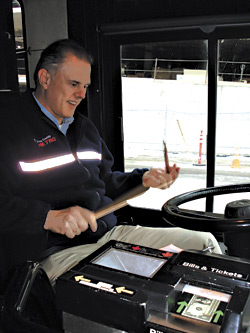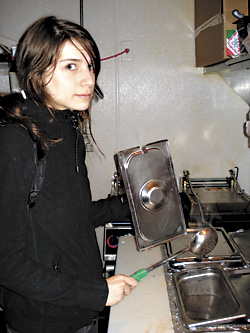Michael Moore plays cello with the Seattle Philharmonic Orchestra. The group includes all kinds of people. There are French teachers and public defenders, molecular biologists and Boeing employees. Like them, Moore also has a day job. He builds sets for Seattle Opera at a large warehouse in Renton.
“It’s all part of the performance,” he says. “You could think of this, 15 miles away from the opera house stage, as being very backstage.”
At the warehouse, Moore climbs to the top of what looks like a metal scaffolding tower.
“We are climbing up to the upper level of the timber tower of the Puritani set. When you look at this set from the audience, you look upstage and you see what appears to be a series of tall timbers. We have the steel structure covered with quarter-inch plywood….And we’ll apply a texture to it, the paint and effects, that will ultimately make it look like huge wooden timbers.”
From where we stand in the studio, we see a warehouse full of activity. There’s a carpentry shop, a painting shop, and a welding shop, all used for building the sets. Moore’s office overlooks the whole enterprise, like the eye of God. But Moore’s not interested in authority.
“Well, you could call me the boss,” he says. “[But] I don’t really think of myself that way. I think of myself as one of the collaborators.”
Of course, all bosses talk this way. But collaboration is a way of life when you play in an orchestra.
“Well, as we play and interpret the music together, we do watch each other. And of course, more important, listen to each other. And it’s phrasing, it’s nuance, it’s subtlety, it’s sometimes bravado.”
In the end, musical performance and set design have something in common: When done well, they both are like magic. You aren’t supposed to notice the details.
“In order to pull a rabbit out of a hat, you have to first put a rabbit into a hat. Which means you have to find a hat, and a very cooperative rabbit.”
Day Job is a look at how musicians pay the rent. To listen to the Day Job podcast, visit www.seattleweekly.com.








